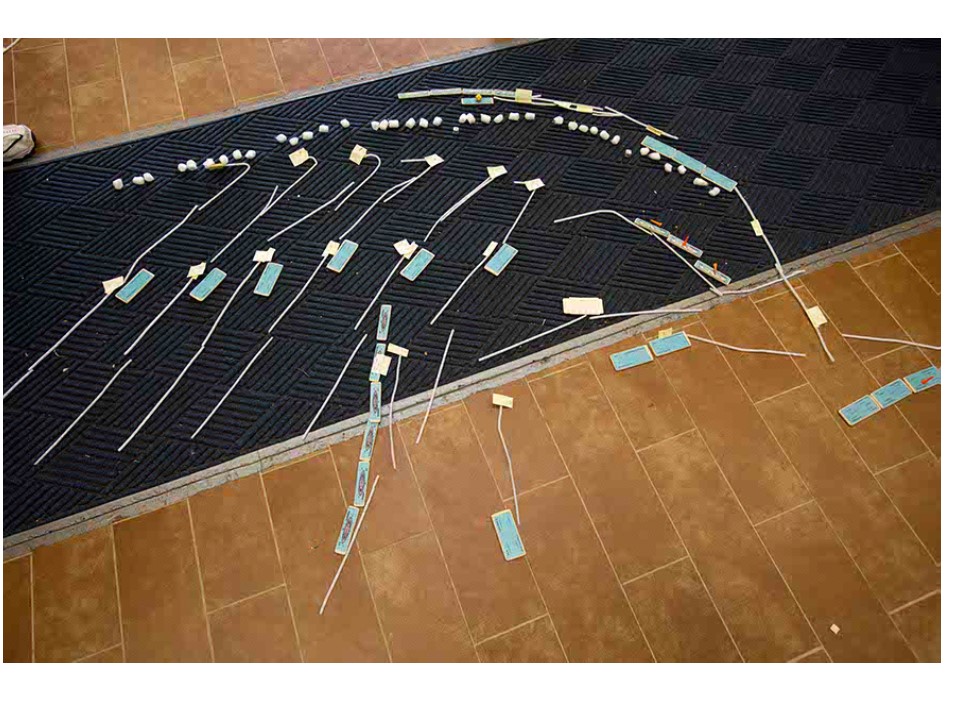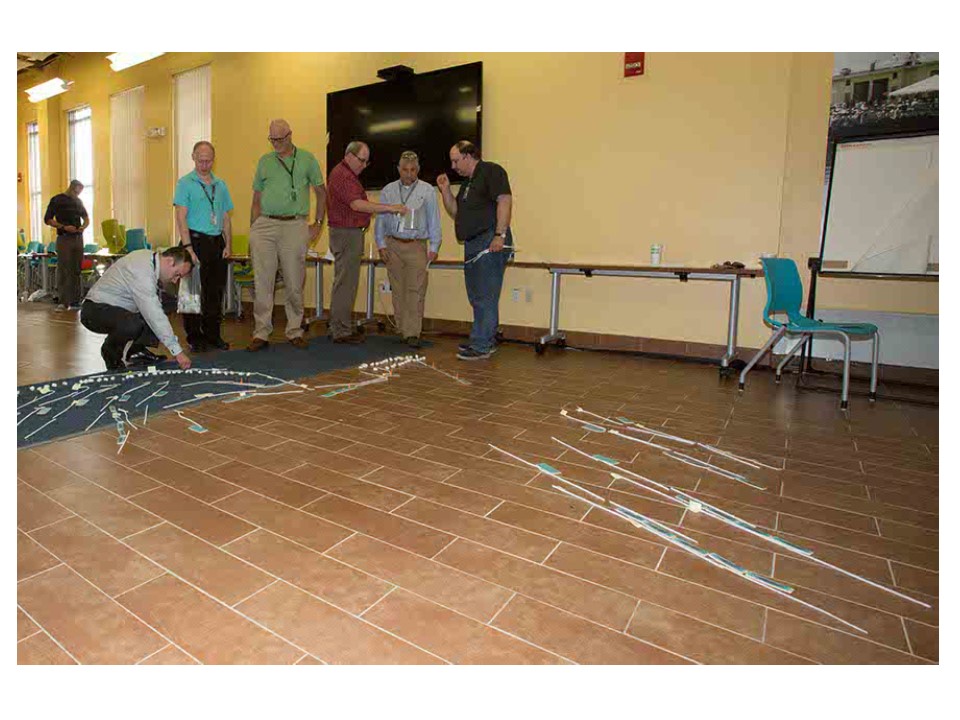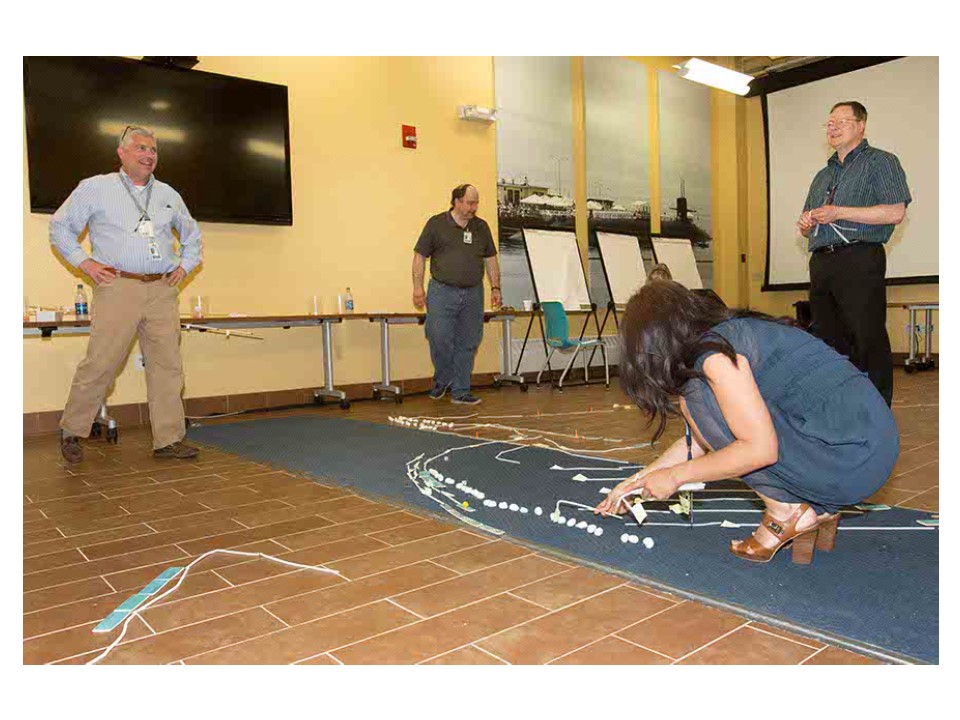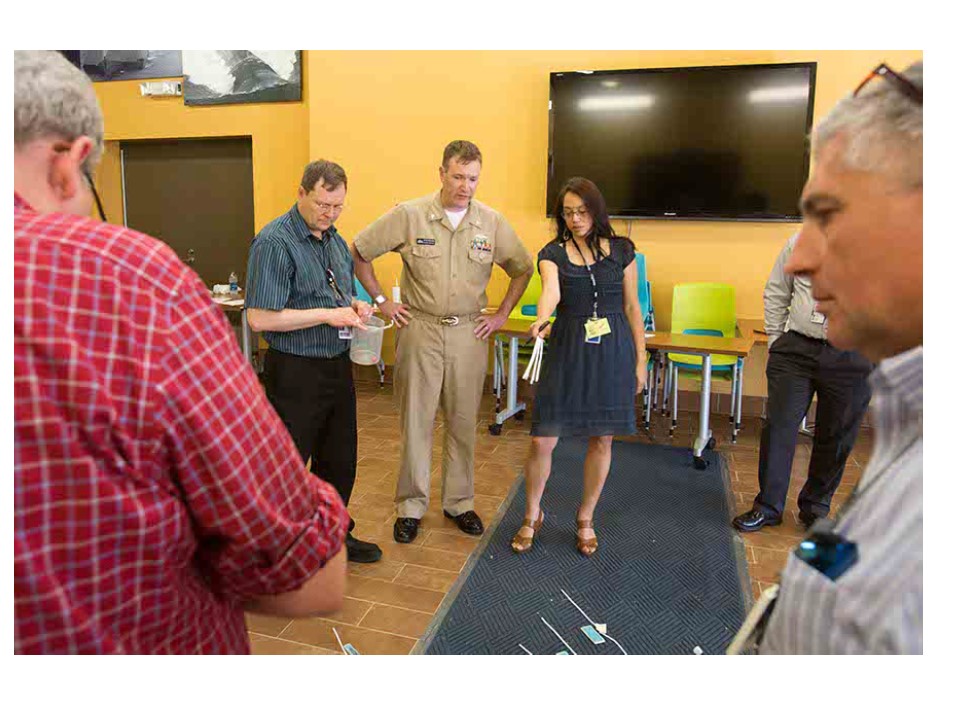
I ended part I with the slide above showing how various types of games make up the spectrum between Experimentation and Analysis. Where these games are cooperative and have players working together to solve a problem, or what in many Euro-style games amounts to “competitive solitaire” I will call them “games”. A label that includes the following sub-types: where the players compete against each other (individually or as part of teams) I consider them “wargames”; where a wargame is implemented in a strictly military context, a “kriegspiel”. Not all wargames are kriegspiels, but all kriegspiels are wargames.
My little pithy quotes are typically chosen to juxtapose with, or amplify the theme of the slide. I use Groucho Marx ‘s great quote here because it represents the sort of frame of reference shift that often characterizes the “a-ha” moments related to abductive reasoning and associative thinking. More on that below. It also illustrates differing levels of abstraction. Fruit flies (noun) being attracted to bananas is pretty much the rationale for them being called “fruit flies”. It is closely tied to direct observation. The analogy between the passage of time and the flight (verb) of an arrow is a sophisticated one that requires comparing two unrelated phenomena in a way that draws out an association that is not directly observable like the case of fruit flies and bananas. I’ll come back to the “nouns vs verbs” thing below as well.
This idea of “abstraction level” or how direct the connection is between the representation of a thing in a game and the “real thing” is a key element in keeping games representative, yet playable. In the diagram above the Exploratory type of game (or workshop) is the most abstract and as you move toward either end, the games become more closely related to reality. The following slides were hidden in my presentation to save time, but will be discussed here.

Despite Mr. Iverson’s protestations, teams are built on practice and for the military, this is particularly true. The closer you can get to “the real thing” in an exercise, the more opportunities there are for cementing teaming relationships. So, in the interest of trying to establish “where activities stop being wargames”, with the exception of some in the media, its rare for someone to consider a military exercise in the field as “a wargame”. As I go through my typology on the following 3 slides, for each I call out how forces are represented, who is making the decisions, and how are interactions are adjudicated. The next most “wargame-like” activity is the CPX/TEWT where the actual commanders and their staffs practice their “battle rhythm” with simulated troops and adjudication that can range from free to rigid kriegspiel-style. When these events feature new or “innovative” capabilities, they are usually considered “wargames”, but as these events are usually training or proficiency certification events, piggy-backing on them to see how the participants use novel capabilities is rarely productive, other to have the novel capability “validated” by having uniformed personnel say they would like to have improved capabilities.It is what I call “experimental games” where you have a situation specifically created to compare “with and without” situations using existing and novel capabilities. The two alternatives may be presented to the players within the same event, or across two or more separate play sessions. The specific situations to be compared should come from previous decision-making games exploring the more general aspects of the challenge being explored.
The key here is to limit the number of “novel capabilities” to what the players can comprehend. Too many times I’ve seen games where literally dozens of new capabilities are dumped on the players in so-called “technology games” where the quality of the briefing of the “quad-charts” determines how effectively the capability is used. These games are held at a lower level of abstraction from the point of view that you have actual or surrogate decision-makers and simulation-based adjudication of interactions between simulated or constructive forces.

At the next higher level of abstraction (and often at the operational vs tactical level as i s the case with an experimental game) you have more general “decision-making games”. These can use current or “future” capabilities, but the players focus on the decision-making involved in employing those capabilities, rather than the “with and without” that characterizes experimental games. The format of these games can take on many forms from the “BOGSAT” workshop to what looks very similar to an Experimental Game. The main difference is the focus on process and planning rather than the more specific suitability, feasibility, acceptability and related criteria experimental games try to get to concerning the proposed capability changes. These games input information from the still more abstract Exploratory games/workshops.
The exploratory category is where the level of abstraction can cause the event to lose any real resemblance to a “wargame” with no real buy-in by the players into the decision-making or any attempt at adjudicating outcomes. These “seminar games” can be very useful for introducing new concepts to a disparate group in an attempt at “norming” the group to a highly level of understanding of the subject matter discussed. There may not be any adjudication at all – what i call “talking about what you might do if you played the game” but never being forced to commit to any course of action necessarily. Exploratory games provide the most value in my experience when the players understand they they are the start of series of efforts that roll down to a decision-making game and from there to a set of experimental games (or right to an experimental game, as the sequence of game types need not always be desirable/possible.
Now to this point we have focused on the “experimental/exercise” end of the spectrum which I characterize as being focused on decision-maker engagement. Typically this is characterized as “warfighter engagement”, though one has to be selective to choose “warfighters” carefully by position and/or experience. While folks in uniform (as I was for 22 years) have extremely valuable and specific skill sets, those who have a broad understanding of the “warfighting context” in a given geographic area, or domain can be difficult to get to attend your game, for the very reason they have that “high demand, low quantity” experience base. There is also a difference between “technical knowledge” of systems and their capabilities and knowledge and insight into the decision-making regarding their wartime employment. Nobody has the exact combination of these knowledge bases, which is why these exploratory games tend to be “the bar the wargamer, the analyst and the warfighter walk into” (see previous unfinished post for ramblings on that inspired by previous events I attended).
That leads us to the transition point in the exploratory gaming realm where we shift from the decision-focused game to the interaction-focused game. This path follows up an exploratory game with a research game, which focuses on exploration “what happens if I… (insert hypothesis to be explored here). In this case the human decision making is ofen scripted and the effect of the change to the system is explored assuming the human decision-making is held relatively constant. The Research game is still abstract enough that decision-effects are considered. just as hypothetical excursions are often considered in decision-making games. This leads us to the less abstract game forms that are increasingly analytic in nature.

Appropriately, just as the “experimental game” is defined as the “sweet spot” between abstraction of the representation of warfare with the focus on how a set of inputs affects human decision-making, the eponymous “analytic game”is at the sweet spot of abstraction balanced with exploring the complex inter-relationships between the myriad “gears of war” with the effects of those pesky “meddling humans” held constant. As the “Cycle of Research” (or in this case “Cycle of Innovation as Peter Perla often calls it in this context), the ‘wheel” can oscillate back and forth from an Exploratory game, to an analytic game, then back to a research game, then to a campaign analysis game, and then back to a CPX. The various forms provide information that can be feed to other types of games, but their is no set sequence that guarantees success.
Just as the line where most would consider the “wargameness” aspect of an event to be nearing zero, or going past it, the area of campaign and tactical analysis can still have game-like qualities. The notion that “a human in the loop simulation is a game” is often not the case, as the human is often not “playing the game” but more “correcting for the fact the simulation behavior model (artificial intelligence) might do something stupid”. Technically that is a decision-making role, but not typically considered the same type of decision-making as a player competing with an adversary.I place campaign analysis before tactical analysis because by its nature it tends to be more abstract, and there is still room for a “player in the loop” if well designed. Tactical analysis often moves totally into the realm of “simulation-based scenario decomposition” where the interference by he pesky humans is minimized (hearkening back to the figure on slide 8).
Just as you can have “real” campaign analysis games (they are rarely used, but might be) there are tactical analysis games that of great use. In many cases these sorts of games involve linking together either actual replica tactical environments (like an airplane cockpit, or a functioning mock-up of a Control Room or Combat Information Center. This the other side of the coin of the CPX where you have actual or surrogate decision-makers but no forces, to in this case you have high fidelity representations of “Forces” but the decision-making is either scripted, or tightly controlled to hold as may possible disrupting variables constant. Like those pesky humans.
So this is my typology relating types of games based on level of abstraction and are focused on increasing fidelity of the decision-making environment while holding the structural complexity of the interactions to an appropriate level of abstraction (the experiment/exercise direction). Or, on the other hand you are holding the interactional complexity of the decision-making environment more or less constant to explore how processes, capabilities, and tactics interplay when changes to the status quo are introduced.
So now the stage is set to discuss a process of using the various types of games (or game-like events for some value of “gameness” greater than zero…) to “innovate” or as we usually mean “be creative”. This process is summarized in the slide below, which I will discussion more detail in Part III. Note that the title of the next slide is meant as a joke, but if you think it makes a better “Cover Story” to give your Boss as to what it is you plan to do, then feel free to use as many of the adjectives as you deem necessary to “get permission to game”. Just never say “role-playing” and “game” in the same sentence. Even enlightened Bosses can’t help but think:
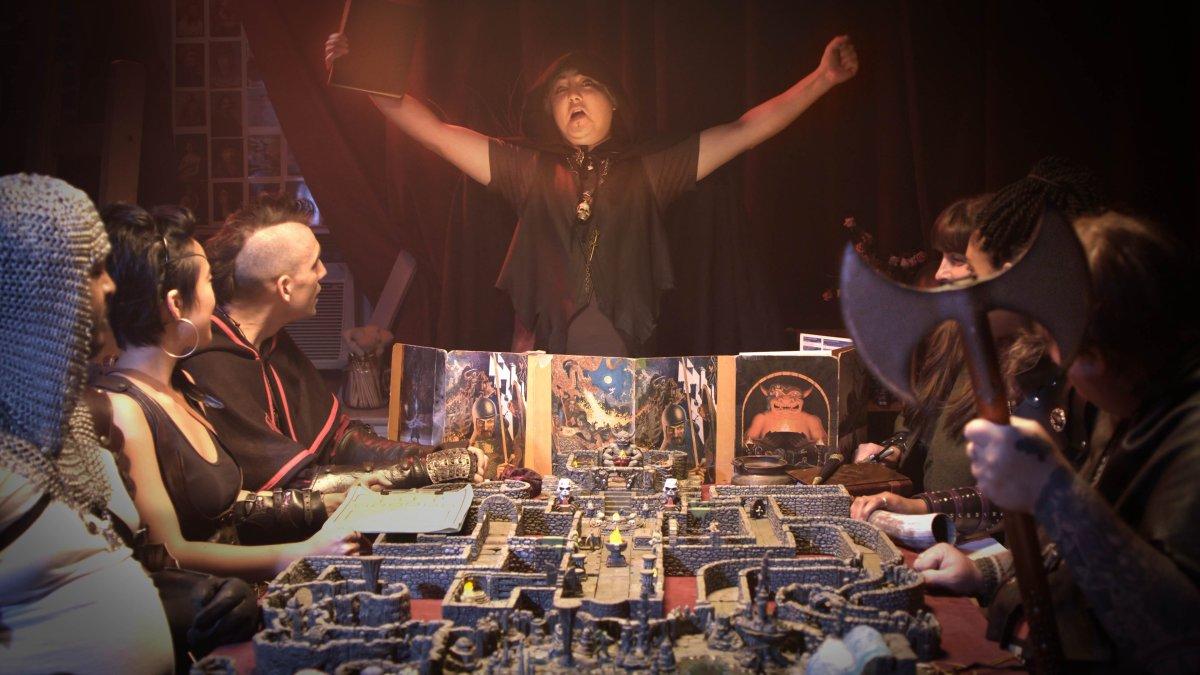
(“Stranger Things” on NETFLIX…Great Show, particularly if you were in the AV club and played D&D in late 70s highschool!)

So all those types of sorts of games are used in various parts of the process outlined above for dealing with that gnawing feeling in your gut that you need you some innovatin’! Each step in the process is described in more detail in Part III. For those who want to read ahead, those slides are provided below:



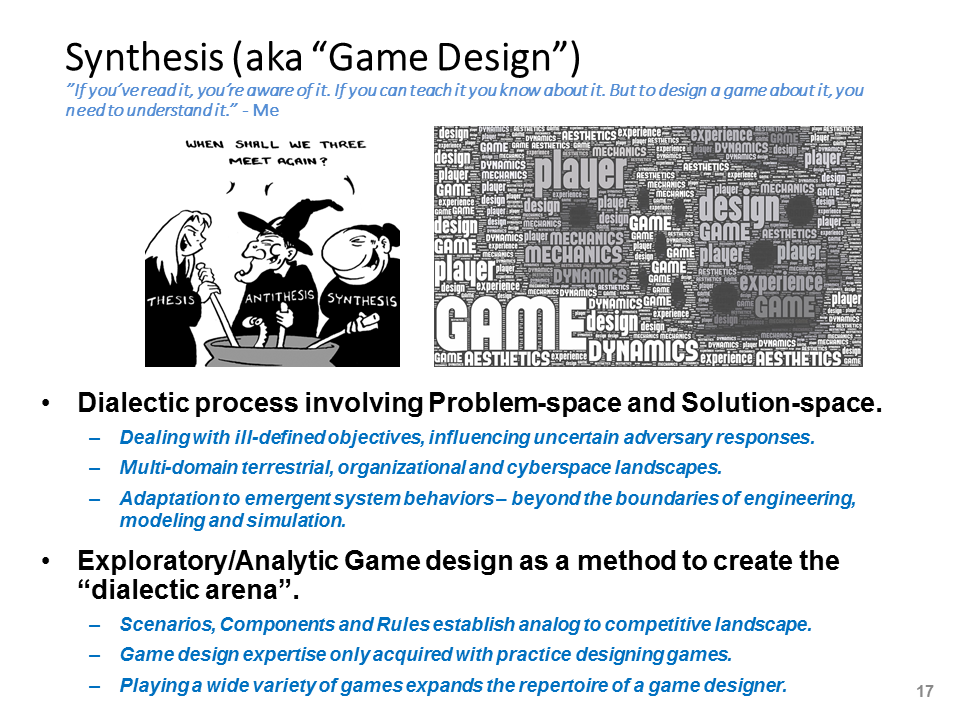
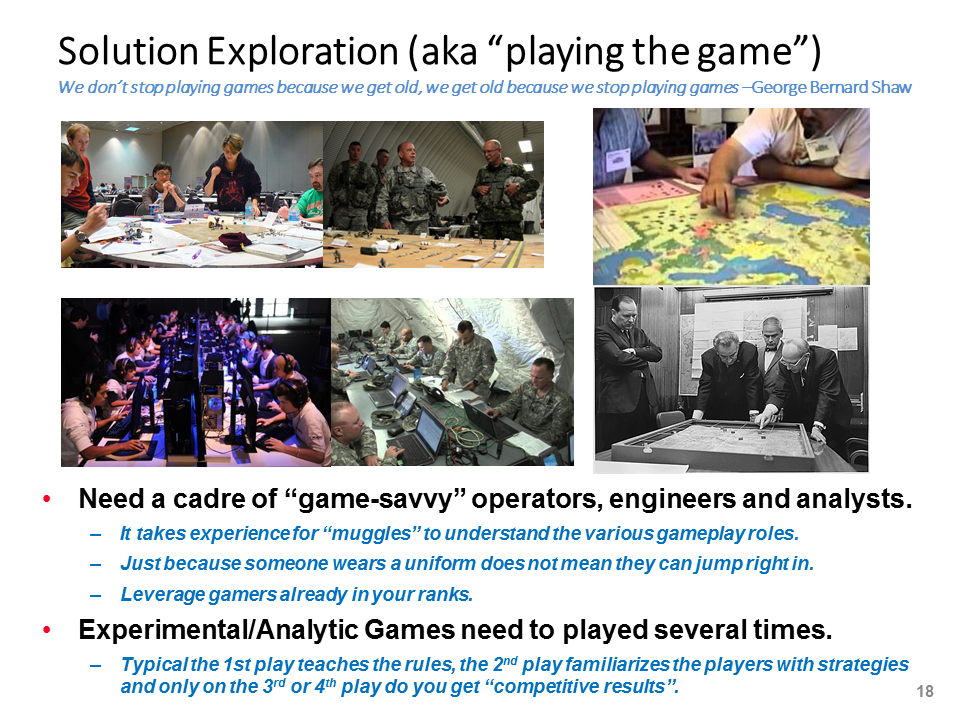
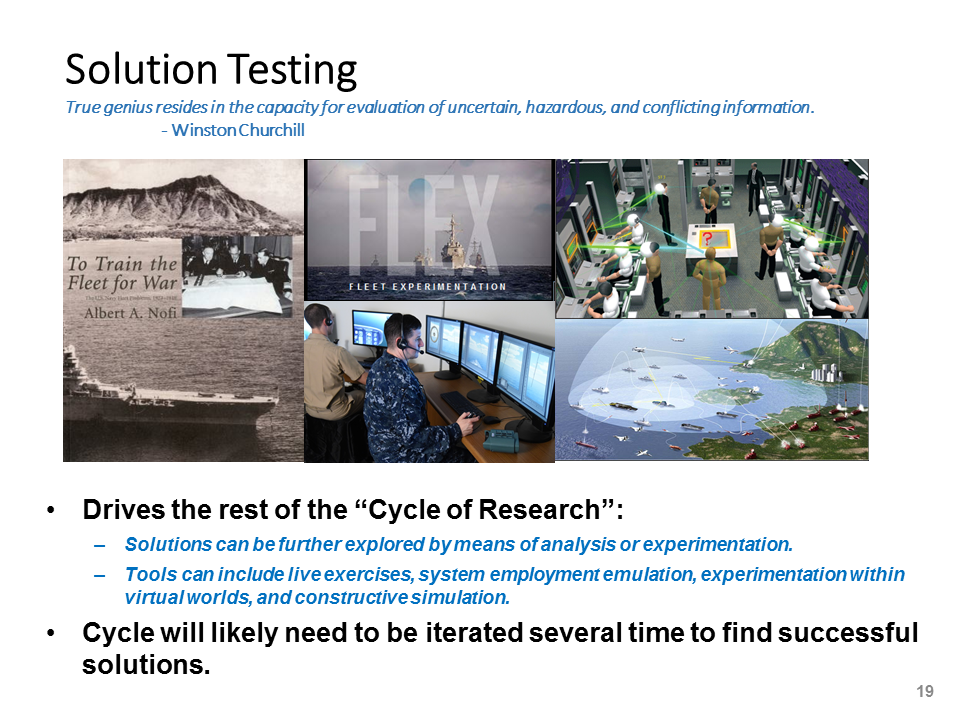
















 All types of games. Euro-style games, hex and counter wargames, matrix-style games, role-playing games (RPG), real-time sims (RTS) and first person shooters (FPS). Manual games and computer games. Even to be a professional player of “serious games” the more gameplay you engage in, the greater the range of game types you can contribute to, and the wider range of game-play experience you can leverage. Despite this being pretty obvious to gamers, its surprising how hard it is to create a professional work environment where members of the workforce feel “permitted to play”. Interminable “lean, six-sigma” meetings, “hack-a-thons” and “slack-a-thons” and “yellow-sticky innovation cells” are encouraged. Try to replace one of those demonstrably less effective techniques with a game-based event and the demands for “proof of ROI” echo down the hallways.A “Game-play champion” as high as possible in the organization (as I have been empowered to do in my organization) is required and even then takes a while. Adding “Gamepaly elements” to the aforementioned types of events is something I’ve found effective in waging a “gaming insurgency”.
All types of games. Euro-style games, hex and counter wargames, matrix-style games, role-playing games (RPG), real-time sims (RTS) and first person shooters (FPS). Manual games and computer games. Even to be a professional player of “serious games” the more gameplay you engage in, the greater the range of game types you can contribute to, and the wider range of game-play experience you can leverage. Despite this being pretty obvious to gamers, its surprising how hard it is to create a professional work environment where members of the workforce feel “permitted to play”. Interminable “lean, six-sigma” meetings, “hack-a-thons” and “slack-a-thons” and “yellow-sticky innovation cells” are encouraged. Try to replace one of those demonstrably less effective techniques with a game-based event and the demands for “proof of ROI” echo down the hallways.A “Game-play champion” as high as possible in the organization (as I have been empowered to do in my organization) is required and even then takes a while. Adding “Gamepaly elements” to the aforementioned types of events is something I’ve found effective in waging a “gaming insurgency”. The meat of my presentation is about Innovation, Technology and Wargaming and the relationship between them as “ends”, “ways” and “means”. I opened with some discussion of what those terms mean to me. I’m a big fan of
The meat of my presentation is about Innovation, Technology and Wargaming and the relationship between them as “ends”, “ways” and “means”. I opened with some discussion of what those terms mean to me. I’m a big fan of 




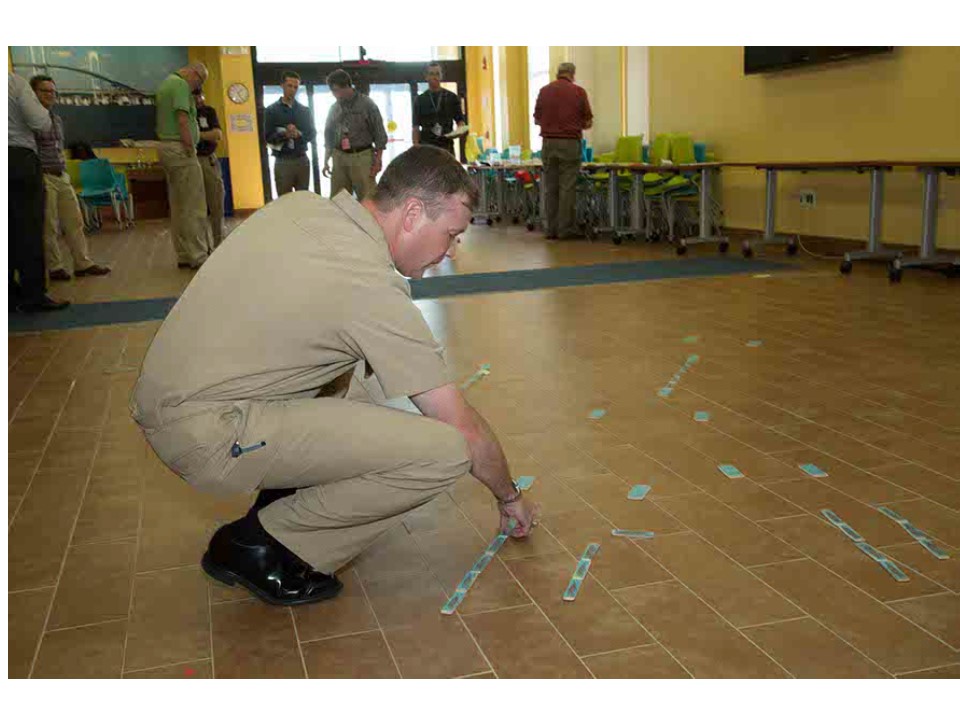
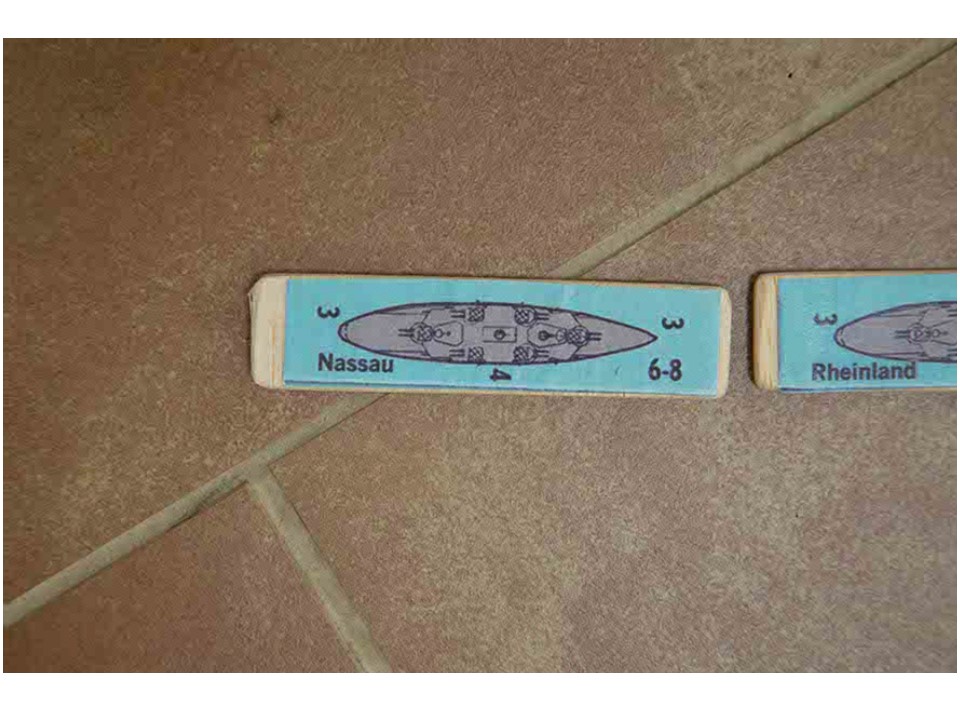 We used pipe cleaners bent into the desired path of ship movement to give orders and facilitate the movement of the ships along on the floor. To represent the time delays associated with command and control of the period, the players “gave orders” for the next turn, ten executed orders for this turn. This was a bit problematic when quarters became close – as it became difficult to avoid fudging by players who put their “orders” out after others. If we had it to be done other, we would have just had the players draw the desired pass on a yellow sticky placed near the formation.
We used pipe cleaners bent into the desired path of ship movement to give orders and facilitate the movement of the ships along on the floor. To represent the time delays associated with command and control of the period, the players “gave orders” for the next turn, ten executed orders for this turn. This was a bit problematic when quarters became close – as it became difficult to avoid fudging by players who put their “orders” out after others. If we had it to be done other, we would have just had the players draw the desired pass on a yellow sticky placed near the formation. 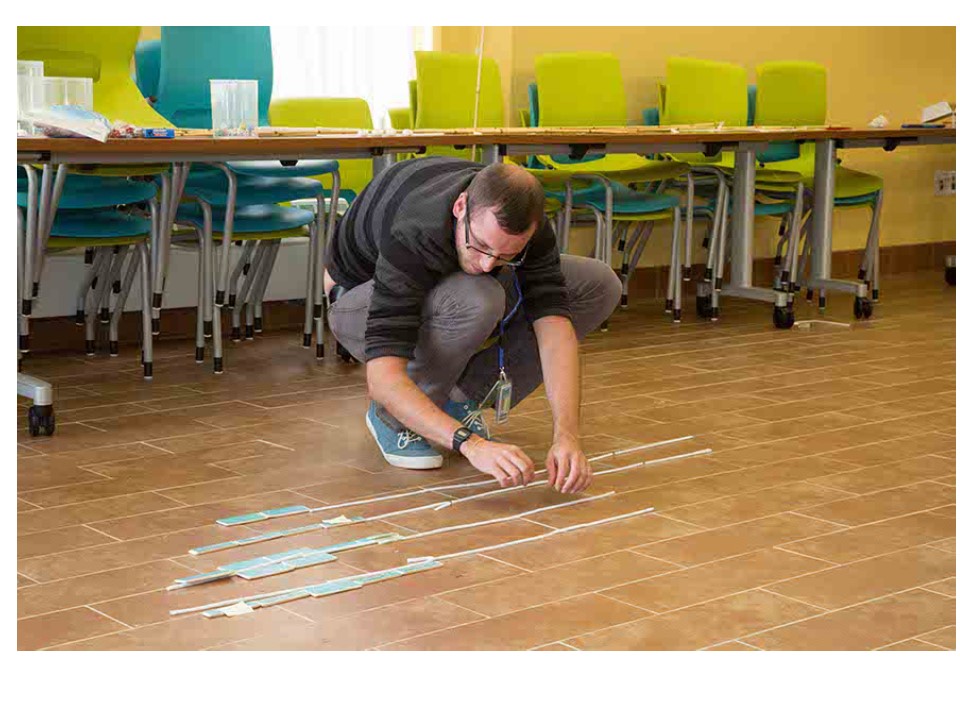 In typical fashion we used range sticks, but as Home Depot apparently no longer make dowels longer than 3ft, Michaels came through with a bundle of decorative bamboo rods, a bit under half an inch in diameter and about 80in (24,000 scale yards) long. These worked perfectly – light weight and just stiff enough not to bend when held out. With range marks every 10 inches to 50in and every 5 after that (as effectiveness dropped off and negative DRMs to fire quickly accrue) it was quick and easier to judge distances.
In typical fashion we used range sticks, but as Home Depot apparently no longer make dowels longer than 3ft, Michaels came through with a bundle of decorative bamboo rods, a bit under half an inch in diameter and about 80in (24,000 scale yards) long. These worked perfectly – light weight and just stiff enough not to bend when held out. With range marks every 10 inches to 50in and every 5 after that (as effectiveness dropped off and negative DRMs to fire quickly accrue) it was quick and easier to judge distances.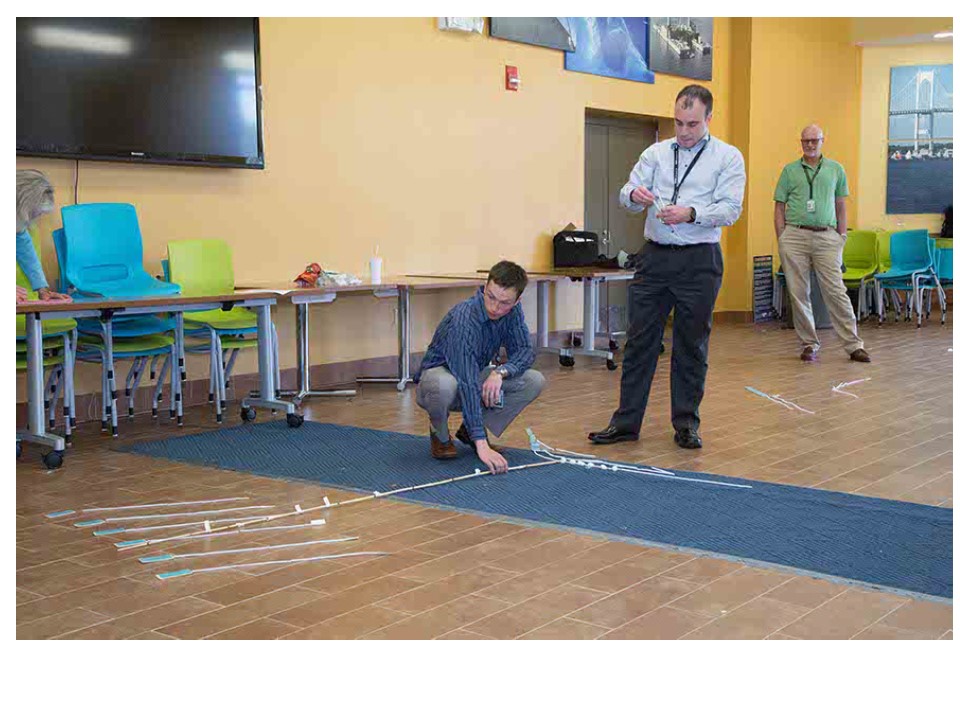 The intention was to use cotton both for “laid smoke” and “firing smoke” but it was apparent that indicating smoke for every firing would delay things far more than it was worth, so that was cast aside and stricken from the rules. To keep things moving, each squadron fired together at an enemy squadron, totaling the firepower points from the Jutland counters. Each firepower point amounted to a roll of a d10 – with a “0” (10) required for a hit. Learning my lesson from the
The intention was to use cotton both for “laid smoke” and “firing smoke” but it was apparent that indicating smoke for every firing would delay things far more than it was worth, so that was cast aside and stricken from the rules. To keep things moving, each squadron fired together at an enemy squadron, totaling the firepower points from the Jutland counters. Each firepower point amounted to a roll of a d10 – with a “0” (10) required for a hit. Learning my lesson from the 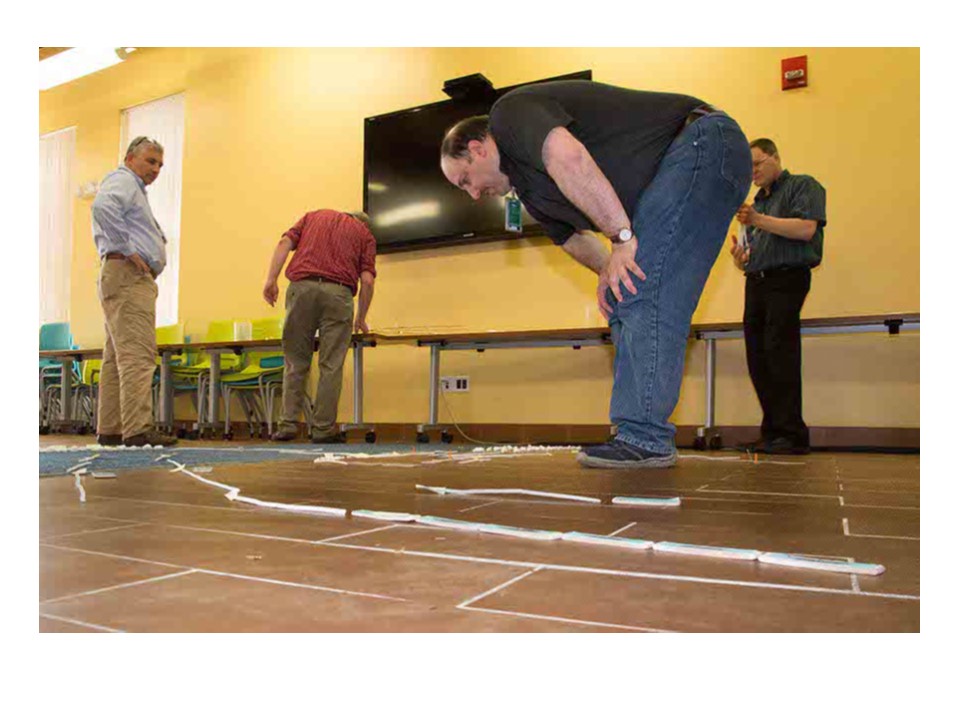 Or matter-of-factly pointing out “oh look, I rolled ANOTHER 9” (Its gotta be the uniform!)
Or matter-of-factly pointing out “oh look, I rolled ANOTHER 9” (Its gotta be the uniform!)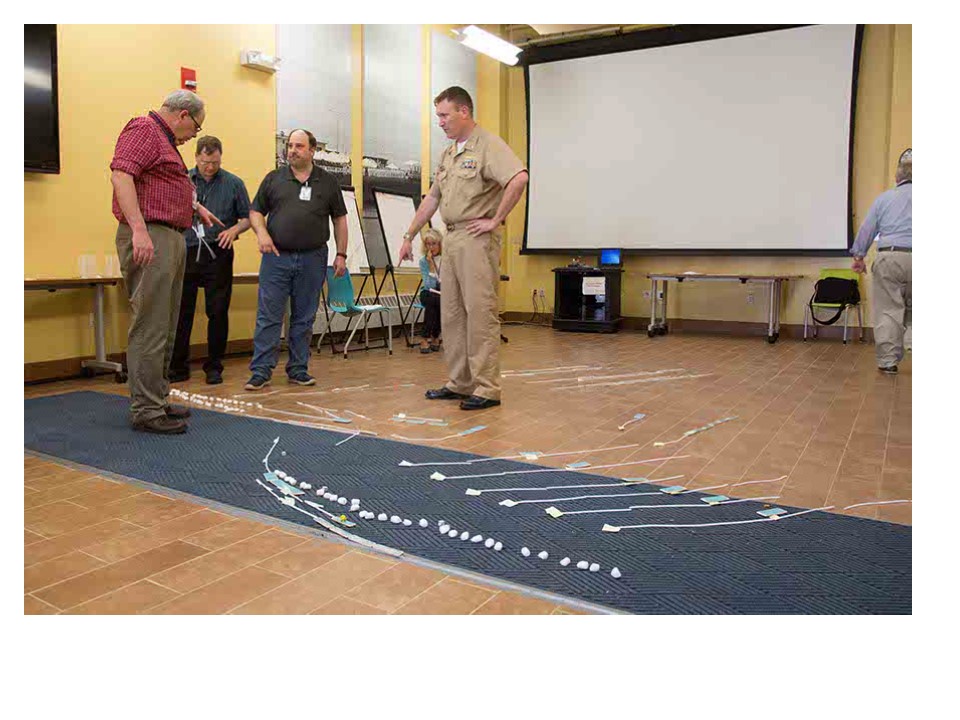 Damage was indicated with stickpins (those with a yellow ball end were cheapest…) and an orange “belch of flame” to indicate “took damage this turn” for later DRMs. Battle cruier vulnerability to big gun fire was taken into acaount with a special die roll when a BC was hit and fired in the same turn. Germans exploded on snake eyes, while the more vulnerable British did so on a 2 or 3. Demonstrating the historical accuracy of the rules, 2 British BCs exploded, right on cue (though one was already little more than a hole in the ocean when it did so). This was indicated with a small pile of belched flame.
Damage was indicated with stickpins (those with a yellow ball end were cheapest…) and an orange “belch of flame” to indicate “took damage this turn” for later DRMs. Battle cruier vulnerability to big gun fire was taken into acaount with a special die roll when a BC was hit and fired in the same turn. Germans exploded on snake eyes, while the more vulnerable British did so on a 2 or 3. Demonstrating the historical accuracy of the rules, 2 British BCs exploded, right on cue (though one was already little more than a hole in the ocean when it did so). This was indicated with a small pile of belched flame.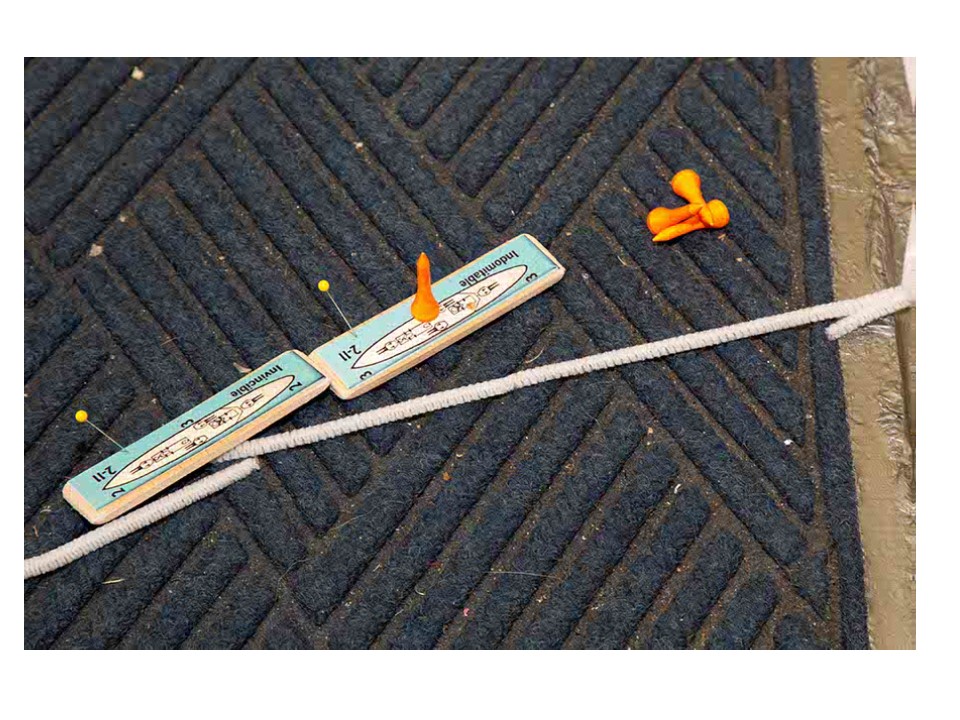 (Yes this was the result of one of those “9”s…)
(Yes this was the result of one of those “9”s…)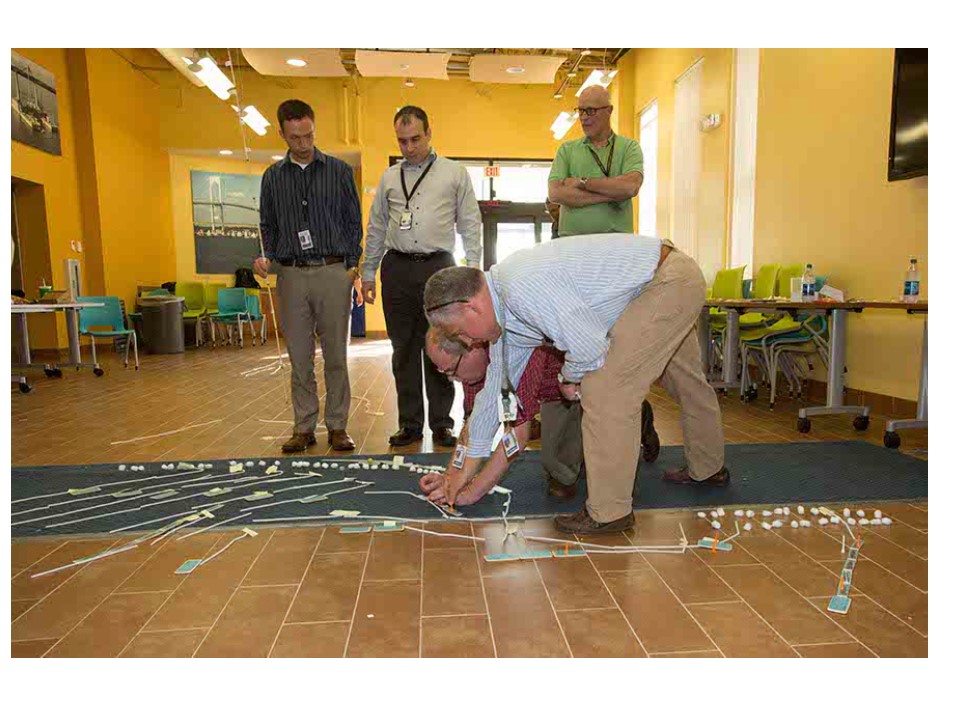 “No, I think its really half an inch closer so I get the +2 DRM for range less than 6yds, don’t you?”
“No, I think its really half an inch closer so I get the +2 DRM for range less than 6yds, don’t you?”